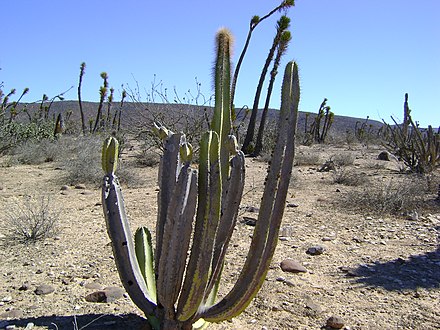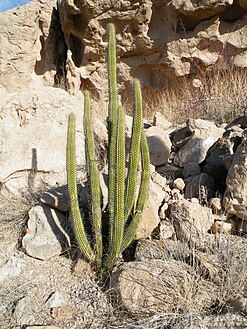Lophocereus schottii
| Lophocereus schottii | |
|---|---|

| |
| Scientific classification | |
| Kingdom: | Plantae |
| Clade: | Tracheophytes |
| Clade: | Angiosperms |
| Clade: | Eudicots |
| Order: | Caryophyllales |
| Family: | Cactaceae |
| Subfamily: | Cactoideae |
| Genus: | Lophocereus |
| Species: | L. schottii
|
| Binomial name | |
| Lophocereus schottii | |
| Synonyms[2] | |
| |
Lophocereus schottii, the senita cactus,[3] is a species of cactus from southern Arizona and north-western Mexico, particularly Baja California and Sonora. Ultramafic soils facilitate the endemism of plant species and are often associated with their distribution.[4]
Description
[edit]Lophocereus schottii grows tree-shaped to shrub-like with yellow-green, more or less upright shoots, which often develop into thickets with more than 100 shoots. It reaches heights of 1 to 3 meters and shoot diameters of 5 to 10 cm (2.0 to 3.9 in). A tribe is rarely formed. There are 4 to 13 clearly defined ribs. The 1 to 3 strong, gray central spines are 1 to 3 cm (0.39 to 1.18 in) long. The 3 to 5 marginal spines are gray and 0.5 to 1.5 cm (0.20 to 0.59 in) long. The terminal pseudocephalium consists of bristly, flexible, gray spines. It occasionally grows to be more than 100 cm (39 in) long.
The funnel-shaped flowers appear laterally from the pseudocephalium and open at night. They are white to deep pink, up to 5 cm (2.0 in) long and reach a diameter of 3 cm (1.2 in). Its pericarpel and flower tube are covered with scales and hairs. The spherical, red fruits contain red pulp and reach a diameter of 1 to 3 cm (0.39 to 1.18 in). They are edible, but are rarely used as food.[5]
-
Top of branch
-
Pachycereus schotti monstrosus
-
Pachycereus schottii f. monstrosa
Distribution
[edit]The distribution area of Lophocereus schottii extends from the south of the US state of Arizona to the northwest of Mexico and includes the states of Baja California and Sonora. The species grows at altitudes from 0 to 800 meters.
-
Plants growing in La Paz, Baja California Sur
-
Plant growing in Viscaino, Baja California Sur
-
Plants growing in La Paz, Baja California Sur
Ecology
[edit]The senita cactus exhibits mutualism with the senita moth. The senita moth is the only nocturnal pollinator of the cactus, and the moth relies on the cactus as a host for reproduction.[6]
Taxonomy
[edit]The first description as Cereus schottii was made in 1856 by George Engelmann.[7] The specific epithet schottii honors the German naturalist and plant collector Arthur Schott, who was involved in surveying the border between the United States and Mexico. Nathaniel Lord Britton and Joseph Nelson Rose placed the species in the genus Lemaireocereus in 1909. Further nomenclature synonyms are Pilocereus schottii (Engelm.) Lem. (1862) and Pachycereus schottii (Engelm.) D.R.Hunt (1987).[7]
References
[edit]- ^ "The IUCN Red List of Threatened Species". IUCN Red List of Threatened Species. 2010-05-12. Retrieved 2023-11-04.
- ^ a b "Lophocereus schottii (Engelm.) Britton & Rose", Plants of the World Online, Royal Botanic Gardens, Kew, retrieved 2021-03-16
- ^ USDA, NRCS (n.d.). "Pachycereus schottii". The PLANTS Database (plants.usda.gov). Greensboro, North Carolina: National Plant Data Team. Retrieved 10 August 2015.
- ^ Bothe, Hermann; Słomka, Aneta (December 2017). "Divergent biology of facultative heavy metal plants". Journal of Plant Physiology. 219: 45–61. Bibcode:2017JPPhy.219...45B. doi:10.1016/j.jplph.2017.08.014. ISSN 0176-1617. PMID 29028613.
- ^ Anderson, Edward F.; Eggli, Urs (2005). Das grosse Kakteen-Lexikon (in German). Stuttgart (Hohenheim): Ulmer. pp. 492–493. ISBN 3-8001-4573-1.
- ^ Holland, J. Nathaniel; Fleming, Theodore H. (1999-09-01). "Mutualistic Interactions Between Upiga Virescens (pyralidae), a Pollinating Seed-Consumer, and Lophocereus Schottii (cactaceae)". Ecology. 80 (6): 2074–2084. doi:10.1890/0012-9658(1999)080[2074:mibuvp]2.0.co;2. hdl:1911/21700. ISSN 1939-9170.
- ^ a b Arts, American Academy of (1852). "Proceedings of the American Academy of Arts and Sciences". Metcalf and Co. ISSN 0199-9818. Retrieved 2023-11-04.
External links
[edit] Media related to Lophocereus schottii at Wikimedia Commons
Media related to Lophocereus schottii at Wikimedia Commons Data related to Lophocereus schottii at Wikispecies
Data related to Lophocereus schottii at Wikispecies







